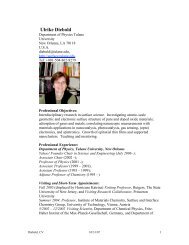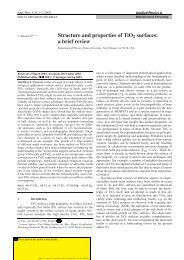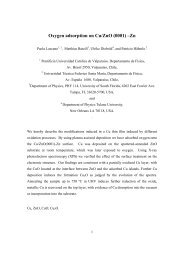The surface science of titanium dioxide - Niser
The surface science of titanium dioxide - Niser
The surface science of titanium dioxide - Niser
You also want an ePaper? Increase the reach of your titles
YUMPU automatically turns print PDFs into web optimized ePapers that Google loves.
92 U. Diebold / Surface Science Reports 48 (2003) 53±229<br />
<strong>The</strong> rosette structure can be explained simplybythe formation <strong>of</strong> (partiallyincomplete) TiO 2 layers<br />
through a growth process where the Ti atoms come from the reduced bulk and the 18 O from the gas<br />
phase. <strong>The</strong> kinetics <strong>of</strong> the growth determines the relative concentration <strong>of</strong> the incomplete structures (the<br />
rosettes and strands) and the (1 1) islands on the <strong>surface</strong>. <strong>The</strong> <strong>surface</strong> is ¯at and (1 1)-terminated<br />
when the growth is slow in comparison with <strong>surface</strong> diffusion processes. This can be achieved in<br />
various ways, either during annealing at high temperatures, Fig. 19f, or when the ¯ux <strong>of</strong> one <strong>of</strong> the<br />
constituents is small (in verylight samples with a small concentration <strong>of</strong> interstitials [156]) or at lower<br />
O 2 background pressures. Conversely, on very dark crystals, or at intermediate temperatures, a<br />
substantial part <strong>of</strong> the <strong>surface</strong> can be covered with rosette networks. Note that 60% <strong>of</strong> the Ti atoms in<br />
the rosettes are fourfold coordinated, whereas the Ti atoms exposed on the (1 1) <strong>surface</strong> are ®vefold<br />
coordinated. Clearlythe possibilitythat such structures can form needs to be taken into account when<br />
preparing rutile (1 1 0) <strong>surface</strong>s for <strong>surface</strong> chemistryexperiments (see Section 5).<br />
<strong>The</strong> <strong>surface</strong> structure in Fig. 19e, obtained after annealing in 1 10 6 mbar 18 O 2 at 710 K, shows the<br />
presence <strong>of</strong> (1 2) strands on otherwise ¯at, (1 1)-terminated <strong>surface</strong>s. This is in agreement with<br />
Onishi and Iwasawa's [169] results described above. From atomicallyresolved images <strong>of</strong> strands<br />
connected to rosettes as well as UHV annealing experiments <strong>of</strong> restructured <strong>surface</strong>s it was concluded<br />
[144] that these strands also have the Ti 2 O 3 structure depicted in Fig. 18b.<br />
<strong>The</strong> dependence <strong>of</strong> the restructuring (as well as the type <strong>of</strong> (1 2) reconstruction) on the reduction<br />
state <strong>of</strong> the bulk was resolved byBennett et al. [76]. High-temperature STM studies were performed on<br />
two different TiO 2 samples. On a dark blue/black crystal (that showed already evidence for CSP<br />
formation, i.e., darker than cube 3 in Fig. 5) two different structures were observed (see Fig. 22). <strong>The</strong><br />
dark and bright strings in Fig. 22 were attributed to added Ti 2 O 3 rows (Fig. 18b) and added rows <strong>of</strong> a<br />
bulk-terminated TiO 2 layer (Fig. 18c, but with bridging oxygens at the center <strong>of</strong> the strands),<br />
respectively. <strong>The</strong> latter structure also appears cross-linked with partial `rosettes' (Fig. 21). Both the<br />
added-row structure and the rosettes are just incomplete TiO 2 structures that form during the growth <strong>of</strong><br />
additional TiO 2 (1 1 0)-(1 1) layers. <strong>The</strong> authors have published impressive web-based STM `movies'<br />
[173] (which can be viewed at http://www.njp.org/) <strong>of</strong> the growth process that show the cyclic<br />
completion <strong>of</strong> terraces and new formation <strong>of</strong> the cross-linked added-row structures. In contrast, the dark<br />
rows (the Ti 2 O 3 added rows) appeared relativelyunreactive for additional growth.<br />
2.2.3. Recommendations for <strong>surface</strong> preparation<br />
Although the TiO 2 (1 1 0)-(1 1) <strong>surface</strong> is considered the `best-characterized', prototypical metal<br />
oxide <strong>surface</strong>, the above summaryclearlyshows that its atomic-level structure is quite complex. <strong>The</strong><br />
recent STM results summarized above clearlyindicate that both the oxidation conditions and the history<br />
<strong>of</strong> the TiO 2 (1 1 0) sample have signi®cant bearing on the morphology<strong>of</strong> the <strong>surface</strong>, the presence <strong>of</strong><br />
strands, rosettes, or CSPs. <strong>The</strong> variations in the <strong>surface</strong> structure with O 2 pressure, crystal temperature and<br />
bulk defect densityare so vast that one could suspect chemistry<strong>of</strong> the TiO 2 (1 1 0) <strong>surface</strong> to be<br />
signi®cantlyvariant for samples oxidized under different conditions. For example, the issue <strong>of</strong> whether<br />
water is molecularlyor dissociativelyadsorbed on TiO 2 (110)[127,128,138,174,175] (see Section 5.1.2)<br />
maybe signi®cantlyclouded in the literature because <strong>of</strong> studies in which the morphology<strong>of</strong> the <strong>surface</strong><br />
was unknowinglydisordered bythe presence <strong>of</strong> the rosettes and/or strands observed recentlybySTM.<br />
This level <strong>of</strong> ambiguitymayalso permeate manyother adsorption studies on TiO 2 (110).<br />
Guidelines <strong>of</strong> <strong>surface</strong> preparation <strong>of</strong> TiO 2 (1 1 0) can be extracted from recent work [75,76,150,156,172].<br />
If solely(1 1)-terminated <strong>surface</strong>s are desired, light blue crystals (as depicted in Fig. 5) should be used.







